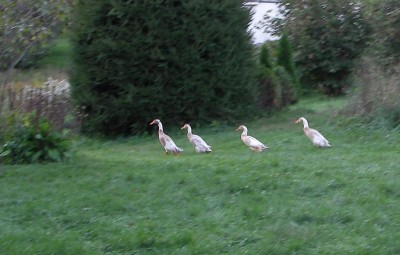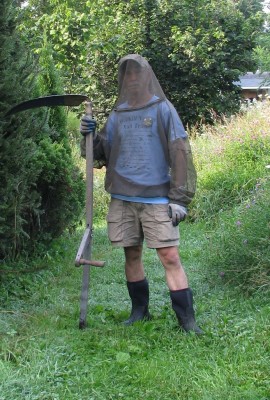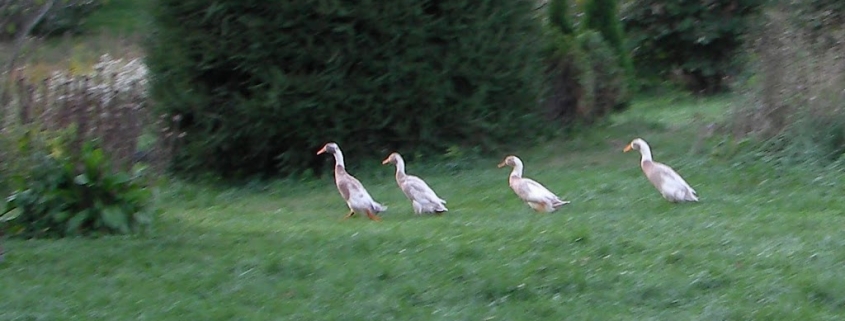[ducks and plums, bug baffler, rethinking doyenne de juillet]
My ducks are as useful as they are humorous. I’ve always appreciated their fast-paced, duck walk patrol of the grounds for various insects on which to feast. But this year I’ve had a bumper crop of plums, and the ducks are being a big help with them also.

I merely bemoan the loss of plums that drop before I get to them; my loss is the duck’s gain. Fruits that dropped because of some insect or disease, however, could provide the beginnings of next year’s insect or disease problems. Plum curculio larvae exit dropped fruits, burrow into the soil, and emerge a month later as adults ready for some more feeding until they find some place to hibernate for winter. So you can imagine how glad I am to see the ducks gobbling up whatever they can get at beneath the plum tree.
Brown rot infected plum fruits shrivel up to become brown “mummies.” On the ground or stuck on the tree, these mummies provide spores for infections next spring. Again, thank you ducks for cleaning up fallen, infected plums.
The ducks make a beeline for the plum tree as soon as they’re let out each morning, their heads and necks racing so far forward that the birds look like they’re about to lose their balance. Go at it ducks. Enjoy and entertain.
*************************************************
What a joy it is to be out in the garden in the early morning. Humanity is quiet, the birds are singing, air is cool, and a mist softens the brightness of rising sun.
Then come the insects, which are especially bothersome this year because of incessant rain. After the 15 minutes or so it takes them to pick up my scents, the bugs are swarming all around my head. They can definitely take the fun out of early morning play.
No problem. I could just douse my skin with either 2-(2-hydroxyethyl)-1-piperidinecarboxylic acid 1-methylpropyl ester) or para-Menthane-3,8-diol. Despite their horrendous sounding names, both these chemicals are quite safe to use, much safer that the commonly used DEET, whose real name, N,N-diethyl-m-toluamide or N,N-diethly-3-methyl-benzamide, is equally horrendous. Those two products I mention are not, of course, sold under those names, but as Picaridin (in, for example, ‘Natrapel’ and ‘Cutter Advanced Insect Repellent’) and Oil of Lemon Eucalyptus (in, for example, ‘Repel Lemon Eucalyptus Insect Repellent Lotion’). Both these products compare favorably with DEET in effectiveness and longevity.

Still, I’d rather not goop anything onto my skin, unless necessary, in the freshness of the morning air. So what I more frequently turn to, and also highly recommend, is Bug Baffler, a mesh suit you just slide on quickly over clothes. A cap keeps the soft mesh away from my face.
Bug Baffler does have two drawbacks. One is that when the mesh is used to cover your face, it slightly obscures vision, especially if bright sun is shining directly on it from the front. And second, Bug Baffler makes me look ridiculous.
***************************************************
I’m beginning to rethink the value of my Doyenné de Juillet pear tree, about which I wrote last week. The pears do not really taste good, although waiting for the first drop before harvesting any could have caught her when she was already over the hill. La Doyenné gets one more chance, next year, and then if she’s not up to snuff, off with her head, and onto the waiting stump I’ll graft a different variety.
As for the remainder of this year’s harvest, the ducks, to whom I throw a few pears every day, seem to enjoy them as much as the much more delectable – to me, at least – plums.





Your blog is so informative. I too have problem with my litchee tree which I planted 12 years ago. It has never flowered or borne fruit. I live in Bangalore, India. Can you please give some suggestion? Thanks.
Thanks. In answer to your question, I’ll just quote from my book, THE PRUNING BOOK (available from my website):
“The tree can be reluctant to flower (making it only a handsome ornamental) because flowering requires just enough cold (or drought) to induce dormancy, but not so much as to damage this somewhat cold-tender tree. Careful management is thus required to keep a tree fruitful wherever the climate is less than ideal. Litchi is a native of China, where the traditional advice is that you should “keep the tree calm” for fruitfulness. Prune when the fruit is ripe, cutting off the last foot or so of stems as you harvest clumps of fruit. In summer, pinch new growth. To control tree size, cut away upright stems. In climates where winters are too warm or wet to induce the natural dormancy needed for flowering, try girdling selected stems in autumn.”
Hope this helps. Let me know.
Hi Lee,
I too so love the early morning in my gardens… but those biting bugs! I have been donning a netted hat as well … with layers and long pants and socks over the cuffs… so the buggers cannot get to my skin. This has been the worse year I have ever experienced and sure takes a bit of the joy out of gardening… especially just trying to enjoy… or photograph the garden. We have had swarms of gnats that have never lived here before… I look forward to September! Also looking forward to scrolling through your great blog. Carol